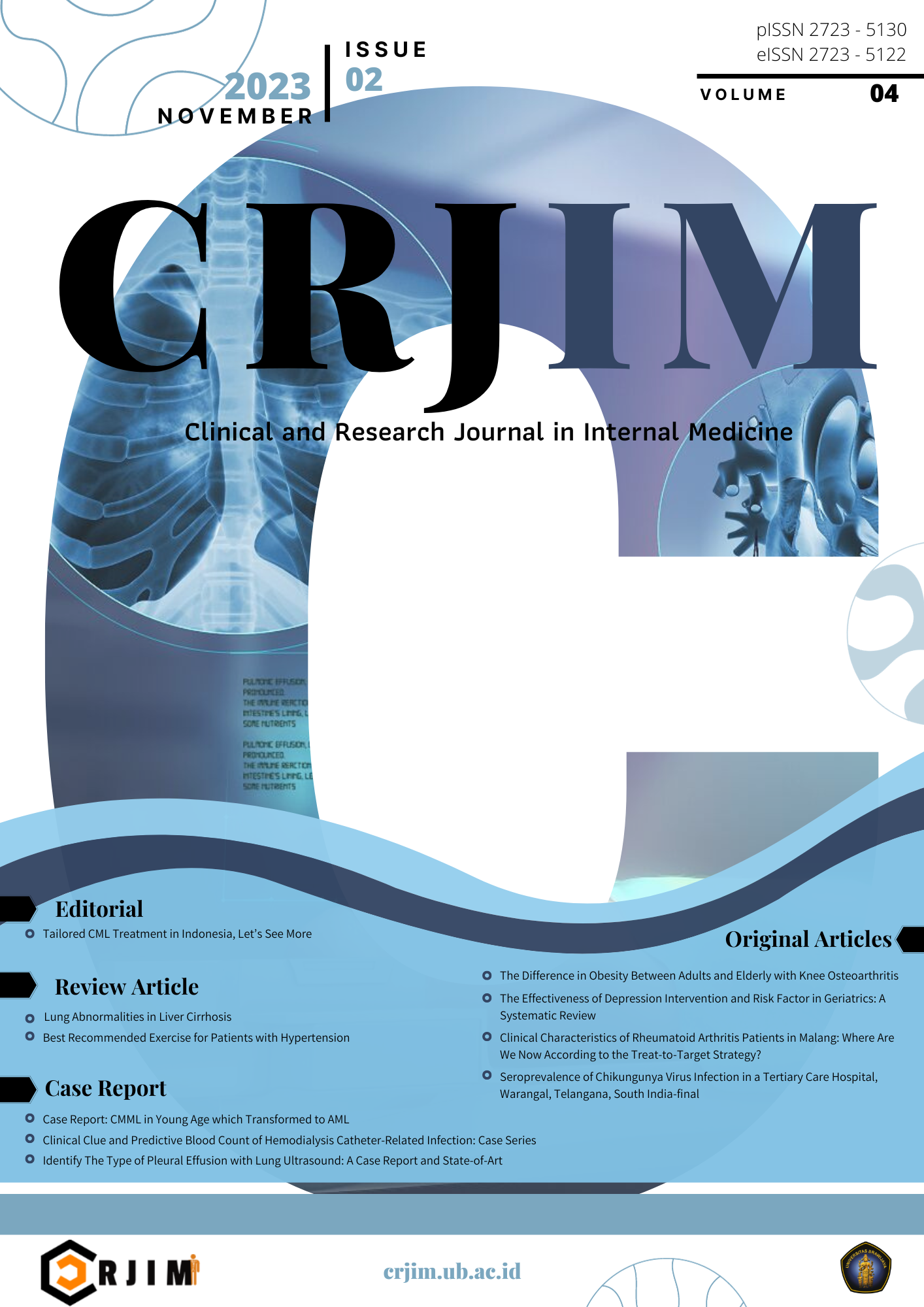Correlation of CD4+CD57+, CD8+CD57+, CD4+KLRG1+, CD8+KLRG1+ T Cells Percentage and Serum MMP-9 Level with Cognitive Dysfunction among Systemic Lupus Erythematosus Patients
DOI:
https://doi.org/10.21776/ub.crjim.2021.002.02.5Keywords:
Systemic Lupus Erythematosus, Immunosenescence, Cognitive DysfunctionAbstract
Background: ‘Lupus brain fog’ is a phenomenon of cognitive function decline in SLE patients. Premature immunosenescence in SLE was presumed to play a significant role in the mechanism of cognitive dysfunction. Aim: To prove the correlation between the terminally-differentiated CD4+CD57+, CD8+CD57+, CD4+KLRG1+, and CD8+KLRG1+ T cells & serum levels of MMP-9 with cognitive dysfunction in SLE patients. Methods: 53 women SLE were conducted to perform MMSE and MoCA-Ina tests to evaluate cognitive function. Immunosenescence was observed by measuring the terminallydifferentiated CD4+CD57+, CD8+CD57+, CD4+KLRG1+, and CD8+KLRG1+ T cells, which were measured by flowcytometry. In addition, MMP-9, an enzyme produced by terminallydifferentiated T cells, was measured using ELISA. Results: SLE patients with cognitive dysfunction based on MMSE and MoCA-Ina test had higher percentage of CD4+CD57+, CD8+CD57+, CD4+KLRG1+, CD8+KLRG1+ T cells and serum levels of MMP-9 compared to patients with normal cognitive function. CD4+CD57+, CD8+CD57+, CD4+KLRG1+, CD8+KLRG1+ T cells percentage and serum MMP-9 level showed negative correlation with both MMSE scores (r = -0.286; r = -0.447; r = -0.279; r = -0.537; r = 0,411) and MoCA-Ina scores (r = -0.454; r = -0.539; r = -0.435; r = -0.535; r = -0.648). Meanwhile, percentage of CD4+CD57+, CD8+CD57+, CD4+KLRG1+ and CD8+KLRG1+ T cells showed positive correlation with serum MMP-9 level (r = 0.292; r = 0.414; r = 0.449; r = 0.374). Conclusion: Expansion of CD4+CD57+, CD8+C57+, CD4+KLRG1+, CD8+KLRG1+ terminally differentiated T cells & increase of serum MMP-9 level are correlated with cognitive dysfunction in SLE patientsReferences
Tangestani Fard M, Stough C. A Review and Hypothesized Model of the Mechanisms That Underpin the Relationship Between Inflammation and Cognition in the Elderly. Front Aging Neurosci. 2019;11:56. Published 2019 Mar 13. doi:10.3389/fnagi.2019.00056
Fukushima Y, Minato N, Hattori M. The impact of senescence-associated T cells on immunosenescence and age-related disorders. Inflamm Regen. 2018;38:24. Published 2018 Dec 24. doi:10.1186/s41232-018-0082-9
Mackay M. Lupus brain fog: a biologic perspective on cognitive impairment, depression, and fatigue in systemic lupus erythematosus. Immunol Res. 2015;63(1-3):26-37. doi:10.1007/s12026-015-8716-3
Ho RC, Husain SF, Ho CS. Cognitive dysfunction in patients with systemic lupus erythematosus: The challenge in diagnosis and management. Rheumatol Pract Res. 2018;3:2059902118792434.
Plantinga L, Lim SS, Bowling CB, Drenkard C. Perceived stress and reported cognitive symptoms among Georgia patients with systemic lupus erythematosus. Lupus. 2017;26(10):1064-1071. doi:10.1177/0961203317693095
Navarrete-Navarrete N, Peralta-RamÃrez MI, Sabio JM, et al. Quality-of-life predictor factors in patients with SLE and their modification after cognitive behavioural therapy. Lupus. 2010;19(14):1632-1639. doi:10.1177/0961203310378413
Alfred S, Khoja L, Anderson M, et al. Cognitive Impairments in SLE Negatively Related to Participation and Quality of Life: A Systematic Review [abstract]. Arthritis Rheumatol. 2019; 71 (suppl 10). https://acrabstracts.org/abstract/cognitive-impairments-in-sle-negatively-related-to-participation-and-quality-of-life-a-systematic-review/. Accessed June 21, 2021.
Calderón J, Flores P, Aguirre JM, et al. Impact of cognitive impairment, depression, disease activity, and disease damage on quality of life in women with systemic lupus erythematosus. Scand J Rheumatol. 2017;46(4):273-280. doi:10.1080/03009742.2016.1206617
Montoya-Ortiz G. Immunosenescence, aging, and systemic lupus erythematous. Autoimmune Dis. 2013;2013:267078. doi:10.1155/2013/267078
Coder B, Wang W, Wang L, et al. Friend or foe: the dichotomous impact of T cells on neuro-de/re-generation during aging. Oncotarget. 2017;8(4):7116-7137. doi:10.18632/oncotarget.12572
Barraclough M, McKie S, Parker B, et al. Altered cognitive function in systemic lupus erythematosus and associations with inflammation and functional and structural brain changes. Ann Rheum Dis. 2019;78(7):934-940. doi:10.1136/annrheumdis-2018-214677
Mackay M, Vo A, Tang CC, et al. Metabolic and microstructural alterations in the SLE brain correlate with cognitive impairment [published online ahead of print, 2019 Jan 10]. JCI Insight. 2019;4(1):e124002. doi:10.1172/jci.insight.124002
Husein N, Lumempouw S, Ramli Y, et al. Uji validitas dan reliabilitas Montreal Cognitive Assesment versi Indonesia (MoCA-Ina) untuk skrining gangguan fungsi kognitif. Neurona. 2010;27(4):15-22.
Setyopranoto I. Reliabilitas dan Validitas Mini Mental State Examination untuk Penapisan Demensia. Log vol 8 No 9 Sept 2002. 2002.
Phetsouphanh C, Aldridge D, Marchi E, et al. Maintenance of Functional CD57+ Cytolytic CD4+ T-Cells in HIV+ Elite Controllers. Front Immunol.2019;10:1844. https://www.frontiersin.org/article/10.3389/fimmu.2019.01844.
Magistrelli L, Storelli E, Rasini E, et al. Relationship between circulating CD4+ T lymphocytes and cognitive impairment in patients with Parkinson's disease. Brain Behav Immun. 2020;89:668-674. doi:10.1016/j.bbi.2020.07.005
Strioga M, Pasukoniene V, Characiejus D. CD8+ CD28- and CD8+ CD57+ T cells and their role in health and disease. Immunology. 2011;134(1):17-32. doi:10.1111/j.1365-2567.2011.03470.x
Stojić-Vukanić Z, Hadžibegović S, Nicole O, et al. CD8+ T Cell-Mediated Mechanisms Contribute to the Progression of Neurocognitive Impairment in Both Multiple Sclerosis and Alzheimer's Disease?. Front Immunol. 2020;11:566225. Published 2020 Nov 19. doi:10.3389/fimmu.2020.566225
Pellicanò M, Larbi A, Goldeck D, et al. Immune profiling of Alzheimer patients. J Neuroimmunol. 2012;242(1-2):52-59. doi:10.1016/j.jneuroim.2011.11.005
Makwana N, Foley B, Fernandez S, et al. CMV drives the expansion of highly functional memory T cells expressing NK-cell receptors in renal transplant recipients. Eur J Immunol. 2017;47(8):1324-1334. doi:10.1002/eji.201747018
Li Y, Hofmann M, Wang Q, et al. Structure of natural killer cell receptor KLRG1 bound to E-cadherin reveals basis for MHC-independent missing self recognition. Immunity. 2009;31(1):35-46. doi:10.1016/j.immuni.2009.04.019
Greenberg SA, Kong SW, Thompson E, et al. Co-inhibitory T cell receptor KLRG1: human cancer expression and efficacy of neutralization in murine cancer models. Oncotarget. 2019;10(14):1399-1406. Published 2019 Feb 15. doi:10.18632/oncotarget.26659
Banh C, Fugère C, Brossay L. Immunoregulatory functions of KLRG1 cadherin interactions are dependent on forward and reverse signaling. Blood. 2009;114(26):5299-5306. doi:10.1182/blood-2009-06-228353
Hirano S, Takeichi M. Cadherins in brain morphogenesis and wiring. Physiol Rev. 2012;92(2):597-634. doi:10.1152/physrev.00014.2011
Novelli L. Expression and function of KLRG1 and IL1R8 in Systemic Lupus Erythematosus. 2019.
Wheeler C, Panwar A, Rentsendorj A, et al. Abnormal CD8 T-Cells induce and track Alzheimer’s-like neurodegeneration. 2021.
Weng NP. Aging of the immune system: how much can the adaptive immune system adapt?. Immunity. 2006;24(5):495-499. doi:10.1016/j.immuni.2006.05.001
Gemechu JM, Bentivoglio M. T Cell Recruitment in the Brain during Normal Aging. Front Cell Neurosci. 2012;6:38. Published 2012 Sep 19. doi:10.3389/fncel.2012.00038
Costantini E, D'Angelo C, Reale M. The Role of Immunosenescence in Neurodegenerative Diseases. Mediators Inflamm. 2018;2018:6039171. Published 2018 Mar 8. doi:10.1155/2018/6039171
Kadowaki M, Nakamura S, Machon O, et al. N-cadherin mediates cortical organization in the mouse brain. Dev Biol. 2007;304(1):22-33. doi:10.1016/j.ydbio.2006.12.014
Rempe RG, Hartz AMS, Bauer B. Matrix metalloproteinases in the brain and blood-brain barrier: Versatile breakers and makers. J Cereb Blood Flow Metab. 2016;36(9):1481-1507. doi:10.1177/0271678X16655551
Bronisz E, Kurkowska-Jastrzębska I. Matrix Metalloproteinase 9 in Epilepsy: The Role of Neuroinflammation in Seizure Development. Eisel U, ed. Mediators Inflamm. 2016;2016:7369020. doi:10.1155/2016/7369020
Iannetta M, Zingaropoli MA, Latronico T, et al. Dynamic changes of MMP-9 plasma levels correlate with JCV reactivation and immune activation in natalizumab-treated multiple sclerosis patients. Sci Rep 9, 311 (2019). https://doi.org/10.1038/s41598-018-36535-5



















